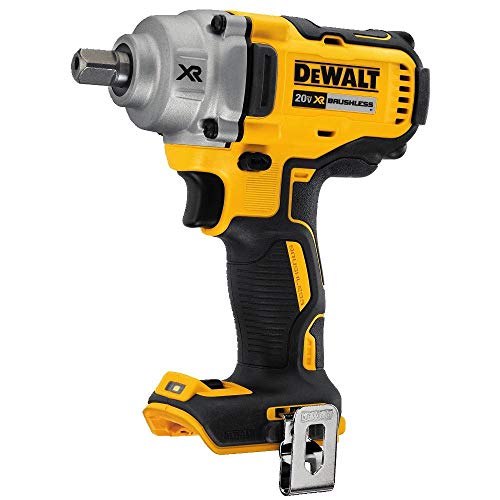Anode rod replacement is a pretty standard part of water heater maintenance. However, finding how much it costs can be challenging, and so many people are left wondering whether it is worth the money to hire a plumber for the task or whether they should pick it up themselves and go the DIY route.
We bring you the ultimate guide and cost estimates for both DIY and professional anode rod replacements.

On average, anode rods cost $30-$40. Cost increases with size. Aluminum is the cheapest; zinc alloys are the most costly. DIY replacement, including the cost of additional tools, can reach $100-$250. Hiring a plumber will likely cost $200-$300, but proper estimates are only provided on inspection.
Average Anode Rod Cost
Anode rods cost anywhere from $5-$10 for short aluminum ones to $70-$80 for zinc anodes. However, it is safe to say that you can buy a good anode rod for $30-$40 on average.
Hiring a Plumber for the Replacement
If you decide to hire a plumber, you should prepare yourself to pay a couple hundred dollars. I did a little research and reached out to a few plumbers to determine how much they charge for anode replacement. And the final answer?
It depends.
Frustrating, I know. But the exact cost ultimately depends on the difficulty of the anode removal, which is basically the combination of how accessible the rod is, what condition it is in, and the type and state of the heater.
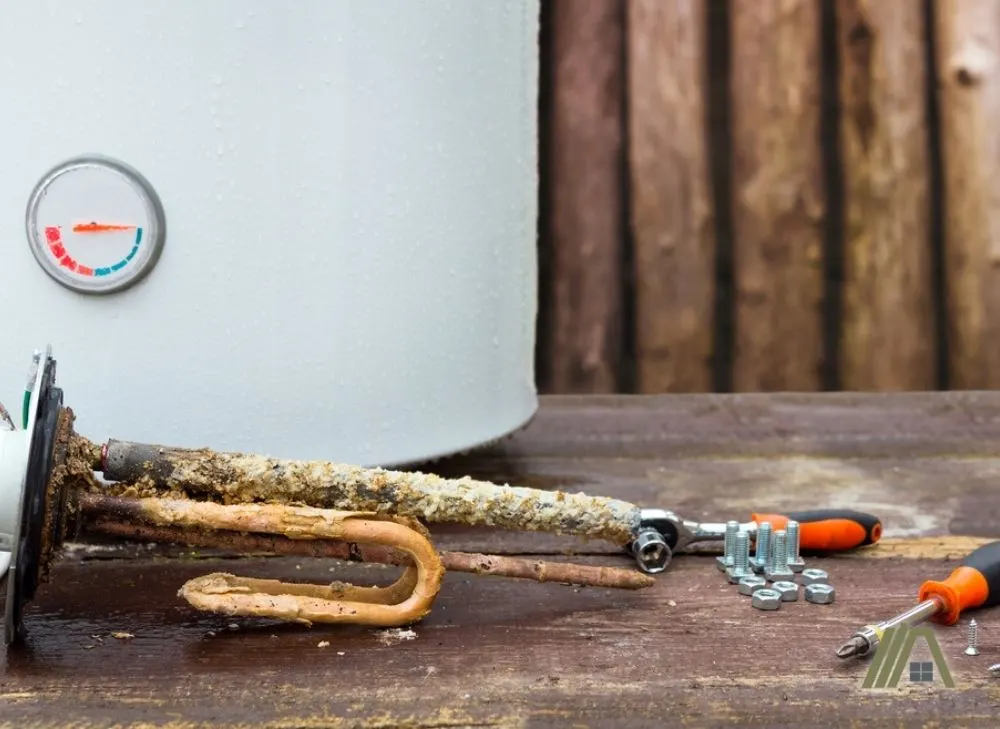
After you contact the plumber, they will need to send a technician into your house to give you a price estimate for the replacement job. The technician will then make an evaluation of the heater and the anode rod and provide you with a quote that you can either accept or decline.
While some plumbers offer this evaluation for free, many will ask for a fee somewhere between $50-$100. Sometimes this charge can be later deducted from the job’s overall cost.
On top of that, we have two types of plumbers: those who charge per hour and those who charge a fixed fee per repair. Either way, you should prepare to pay around $200-$300.
The one plumber that was prepared to give me an estimate without seeing the water heater quoted $260 to replace the anode rod in a 50-gallon electric water heater. This price included labor, materials, and tax.
What Affects the Cost of Replacement?
There are many factors that affect the final cost of anode rod replacement. It could even happen that the cost of replacing the same type of rod on the same model of water heater will differ significantly, depending on who does the job and what condition is the old rod in.
Let’s look at the most important cost-influencing factors to give you a better idea of what price range your replacement will most likely be in.
Who Does the Replacement
Your choice between replacing the anode yourself or hiring a plumber to do it is perhaps the one decision with the most significant impact on the final price of this maintenance job.
The DIY option can be radically cheaper, provided that you already own all the necessary tools. Presuming that you do and that the removal goes smoothly, it can cost you as little as is the price of one new anode rod.
But the overall cost could quickly escalate if you were to deal with complications such as a seized and unaccessible rod. Then you would be forced to buy additional tools that can allow you to fix these mishaps. And suddenly, we are talking about a sum of $100-$250 you need to pay for your DIY job. That doesn’t sound nearly as appealing anymore.
To be fair, the cost is not the only thing you should consider when choosing between these two replacement scenarios.
If the rod is seized and hard to access, you do not have much DIY experience, or you suspect that the heater needs more complex maintenance, it could be a good idea to call a professional. It can prevent you from accidentally causing any damage to the tank, plus it will undoubtedly save you a lot of time.
However, if you are a diehard DIY person who has the time and wants to try a new task, then you have an excellent opportunity to save a bit of money while perfecting your skills.
Type and Dimensions of the Anode Rod
One of the most crucial parts of anode rod replacement happens before the replacement takes place. It is choosing the right anode rod. This seemingly simple task can determine the success of the replacement as well as the effectiveness and lifespan of the anode rod.
Your first option is to stick with the same type of rod the manufacturer used for the heater in the first place. You should be able to find the necessary information about the rod in your user manual or by looking up your heater model number on the internet.
However, even two of the same water heaters may require a different type of rod based on their location.
The best way to choose the perfect anode rod is to consider how tall your heater is, how low is your ceiling clearance, and what water quality you have. All these factors will affect the exact type, size, and dimensions of the anode rod that you need and ultimately affect the price you need to pay for the rod itself.
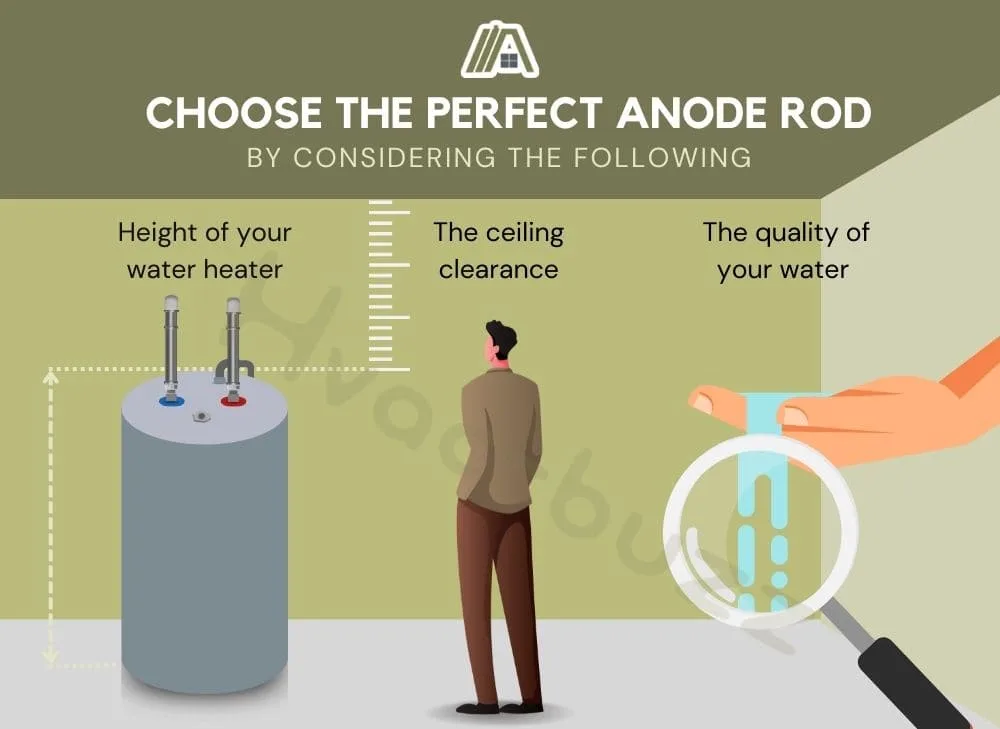
Dimension-wise, I recommend you pick the same size rod as the manufacturer did. That way, you will avoid having to cut the new anode or install an overly long rod that could potentially damage the fragile bottom of your tank. Bigger rods will naturally be more expensive than their smaller but identical material counterparts.
If your ceiling space is limited, then you will have to opt for a flexible anode that tends to be slightly more expensive than the regular one.
Lastly, the material is the most price-defining factor of the anodes. Sacrificial anode rods can be made from different materials (aluminum, magnesium, zinc), from which some are more costly than others.
Aluminum rods are the cheapest of the three. Magnesium anodes are in the midprice range, while zinc rods or zinc and aluminum (sometimes also tin) alloys are generally the most expensive anode rods.
Complications in Removing Old Rod
We have already touched on the main potential complications with the anode removal and replacement—the rod could be broken off or seized. These problems can affect the price in multiple ways.
If you are having the replacement done by a plumber, seized or broken rods will increase the time taken and the job’s difficulty. Whether they charge you per hour or per task, your expenses automatically grow.
If you are changing the rod yourself, you will likely need to buy additional equipment to complete the job.
There are multiple tricks for dealing with a seized anode rod. Some people suggest slipping a steel pipe onto a ratchet handle (wrench) to create better leverage or using a hammer to hit the handle, thus applying more force.
With both of these options, you will most likely need to call an extra person to help you out by holding the tank in its place.
You should exercise maximum caution; otherwise, you could easily damage the tank’s pressure release valve, inner glass-lining, or other components of the heater. This would again cause the costs to rise.
A less physically demanding way of removing a seized rod is to invest in an impact wrench. But you have to remain careful regardless.
If the old rod has broken off and fallen into the tank, you will probably have to flush the tank at least. In the worst-case scenario that the rod caused damage or got stuck somewhere, you will need to pay a plumber for any required repairs.
Should You Replace the Anode Rod Yourself?
The average lifespan of an anode rod is between 3-5 years. If you don’t care for handy jobs, and can afford it, then calling a plumber every few years to have your anode maintenance quickly dealt with, seems like a reasonable choice.
However, there are circumstances when people need to change their anodes much more frequently. Due to the natural properties of the water, you may end up needing to replace the rod once a year or, in extreme cases, even once every six months.
Such frequent visits of a plumber could present a serious hit to your wallet. And so it can pay off, in the end, to set yourself up to replace the anode rod yourself.
The anode rod needs to be changed more often when:
- You use a water softener – the sodium in water softeners causes anodes to corrode more quickly. The ideal material for the sacrificial anode in this situation is magnesium.
- The water is very hard – hard water contains many mineral components that build up in the heater and negatively affect its efficiency. They can also build up on the anode rod, causing it to stop deteriorating and protecting the tank. Aluminum rods are the best-suited sacrificial rods for hard water.
- You run the heater at the highest temperature and use a lot of water – high temperature increases the conductivity of the water, causing the anode to deplete faster. The more you use the heater, the faster the anode corrodes itself.
DIY Anode Rod Replacement Cost
Even though DIY rod replacement can be considerably cheaper than hiring a plumber, you will not get away without paying certain expenses. Setting aside the cost of the anode rod itself, which we have already covered, there are certain tools that you likely don’t own and will have to purchase to complete this task.
Keep in mind that while a regular replacement does not call for many expensive tools, their cost will gradually increase if you end up having some complications removing the anode rod.
What You Need to Replace the Anode
| Tool | Amazon link |
| 1/2 drive socket wrench | View |
| 1 1/16 socket | View |
| Breaker bar (optional, but highly recommended) | View |
| Wire brush (optional) | View |
| Teflon tape | View |
| Needle nose pliers (optional) | View |
| Bucket or Garden hose | View or View |
Possible additional tools
| Tool | Amazon link | When to use it? |
| Impact wrench | View | If the anode rod is seized |
| Hacksaw | View | Whenever you need to cut the rod |
How Long Will the Replacement Take?
Depending on the type of your water heater and the anode rod and what condition they are in, the time it takes to replace it varies anywhere from 20 minutes up to a few hours.
It makes a significant difference in the duration of the repair when the rod is seized or needs to be cut off and taken out by pieces due to its hard access.
Experience plays an important role as well. If this is your first time changing an anode rod or if you are not handy with tools, it will take you longer than it would take a professional plumber or even someone with more DIY and water heater maintenance experience.
It is common practice to flush the water heater while performing anode maintenance, which will undoubtedly add around 10-20 minutes to the whole process.
Replacing an Anode Rod
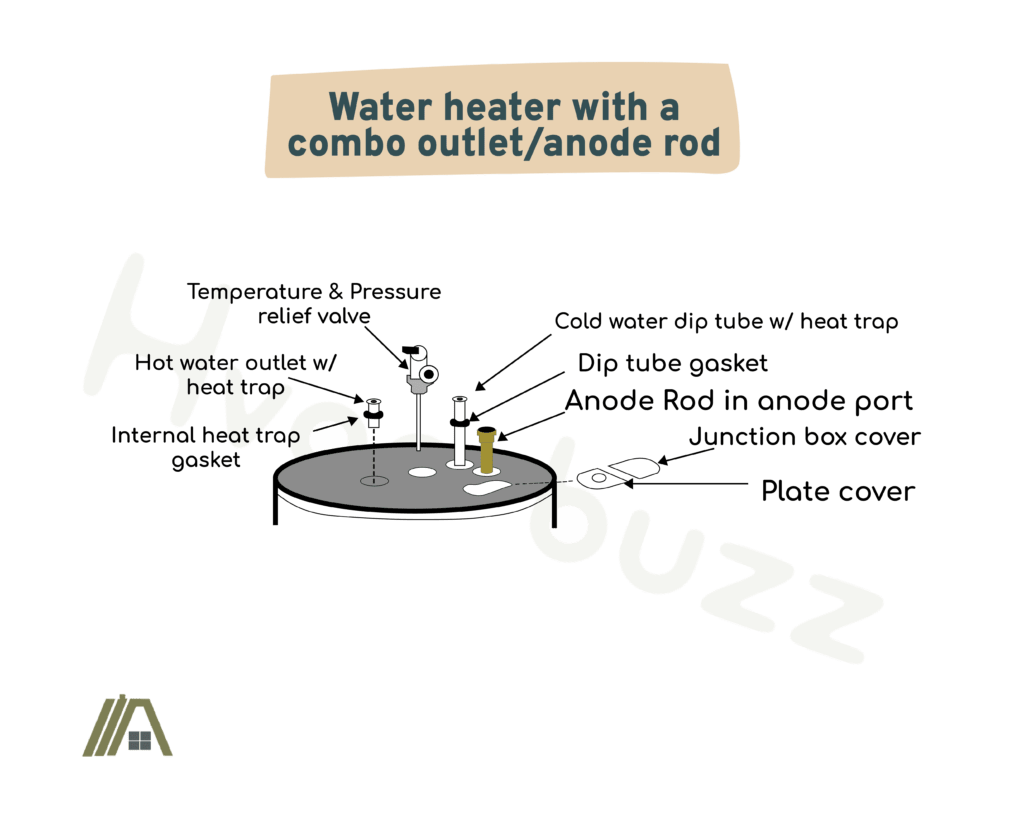
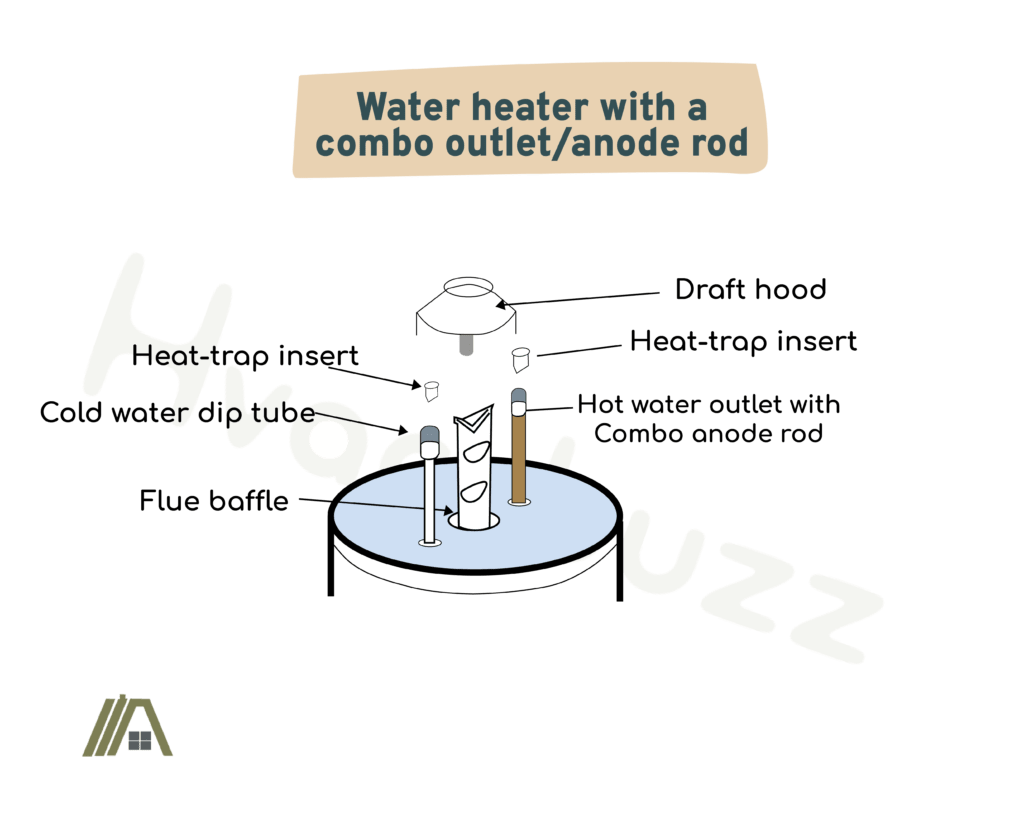
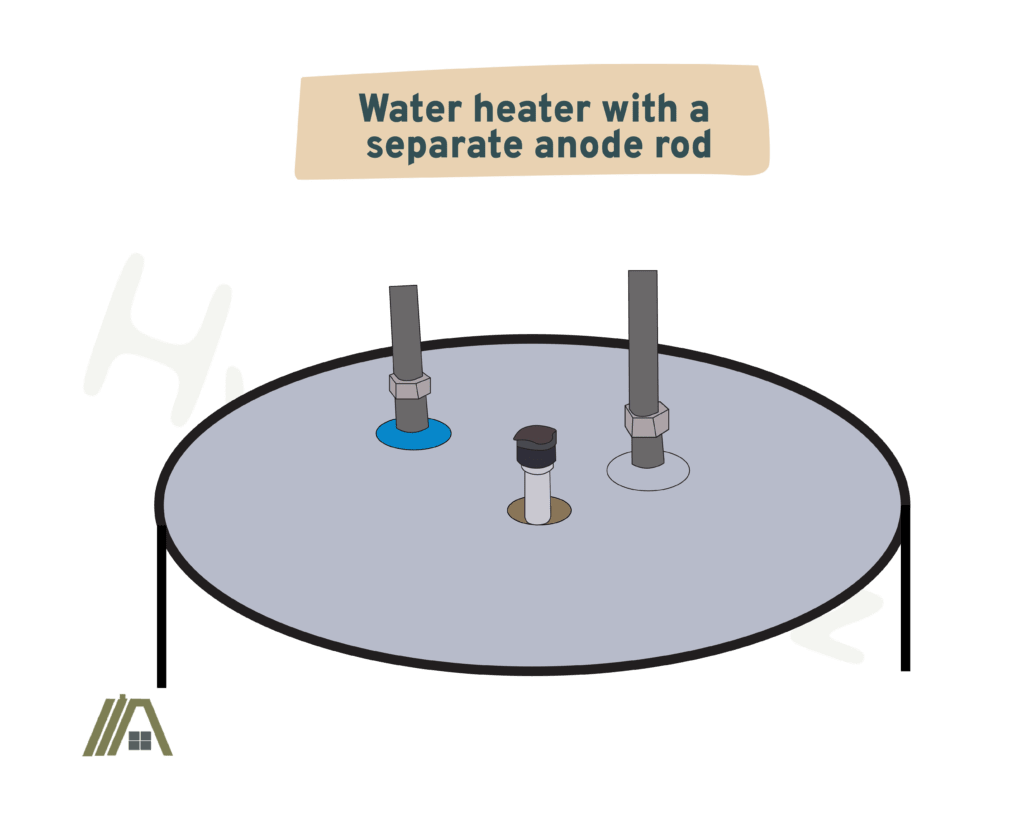
The process of replacing the anode rod will be slightly different depending on the type and model of your water heater. Each heater should come with a user manual that includes the exact instructions on where the anode rod is located and how to replace it.
You should carefully read those to avoid any safety hazards and material damages.
Generally, there are two types of anodes. One has a nipple that goes directly on the hot water outlet. The other is located in a separate location, typically either sticking out at the top of the water heater or hidden under a plug.
It is important to know which type your heater has in order to avoid unscrewing something that is not an anode!
This video will walk you through all the safety tips, removal, and installation of an anode rod.
People with heater models that have a rod going into the hot water outlet (such as Bradford White heaters) can check out this video.
If you are struggling with a seized anode rod, watch this video to see how to use an impact wrench in this kind of situation.
Alternatively, you can watch the video below for other strategies on how to deal with seized anode rods.
Sources
https://www.youtube.com/watch?v=pxODVsgHRfc
https://www.plumbingsupply.com/anoderods.html
https://redcapplumbing.com/help-guides/buyers/cost-to-repair-water-heater-in-florida

